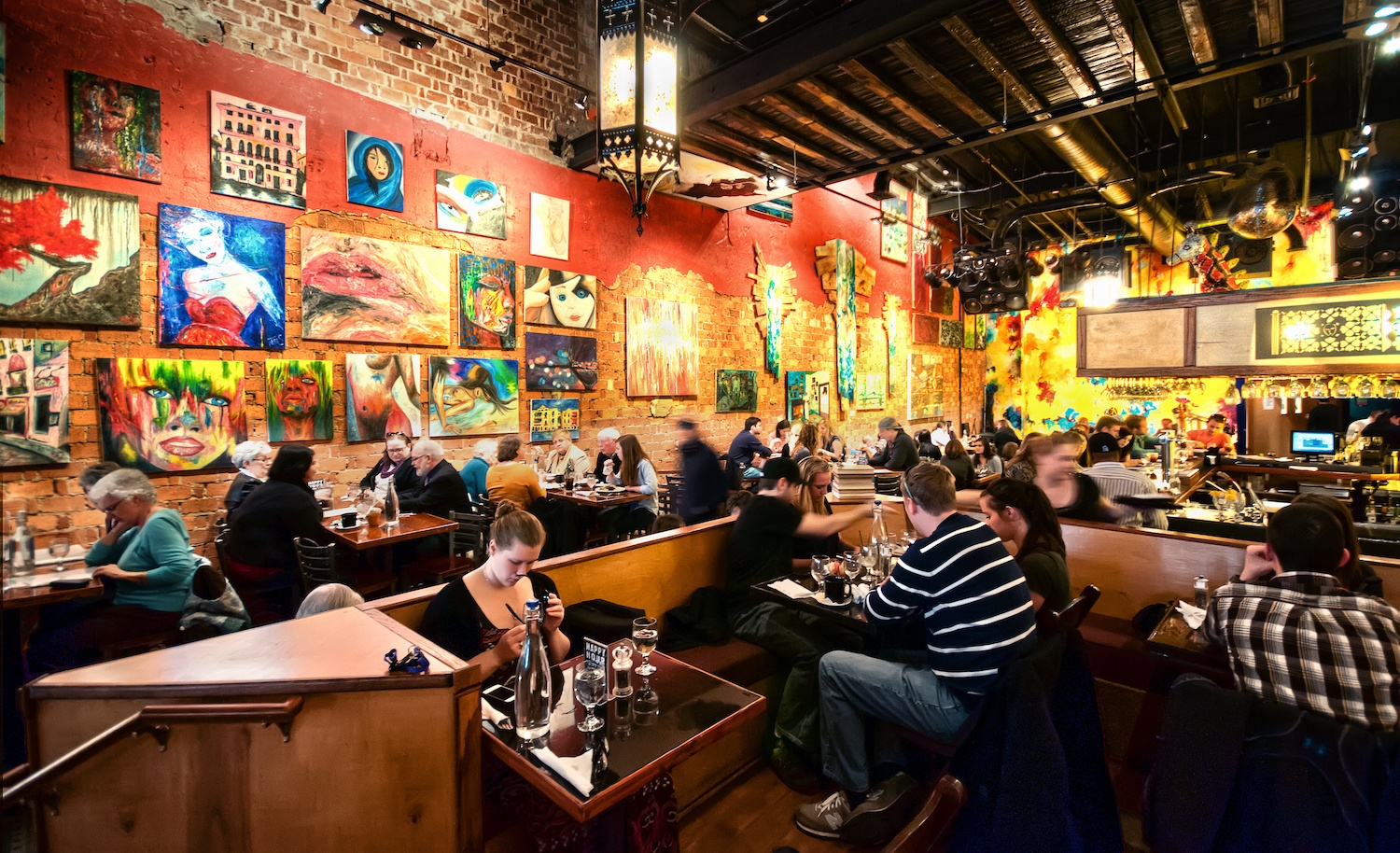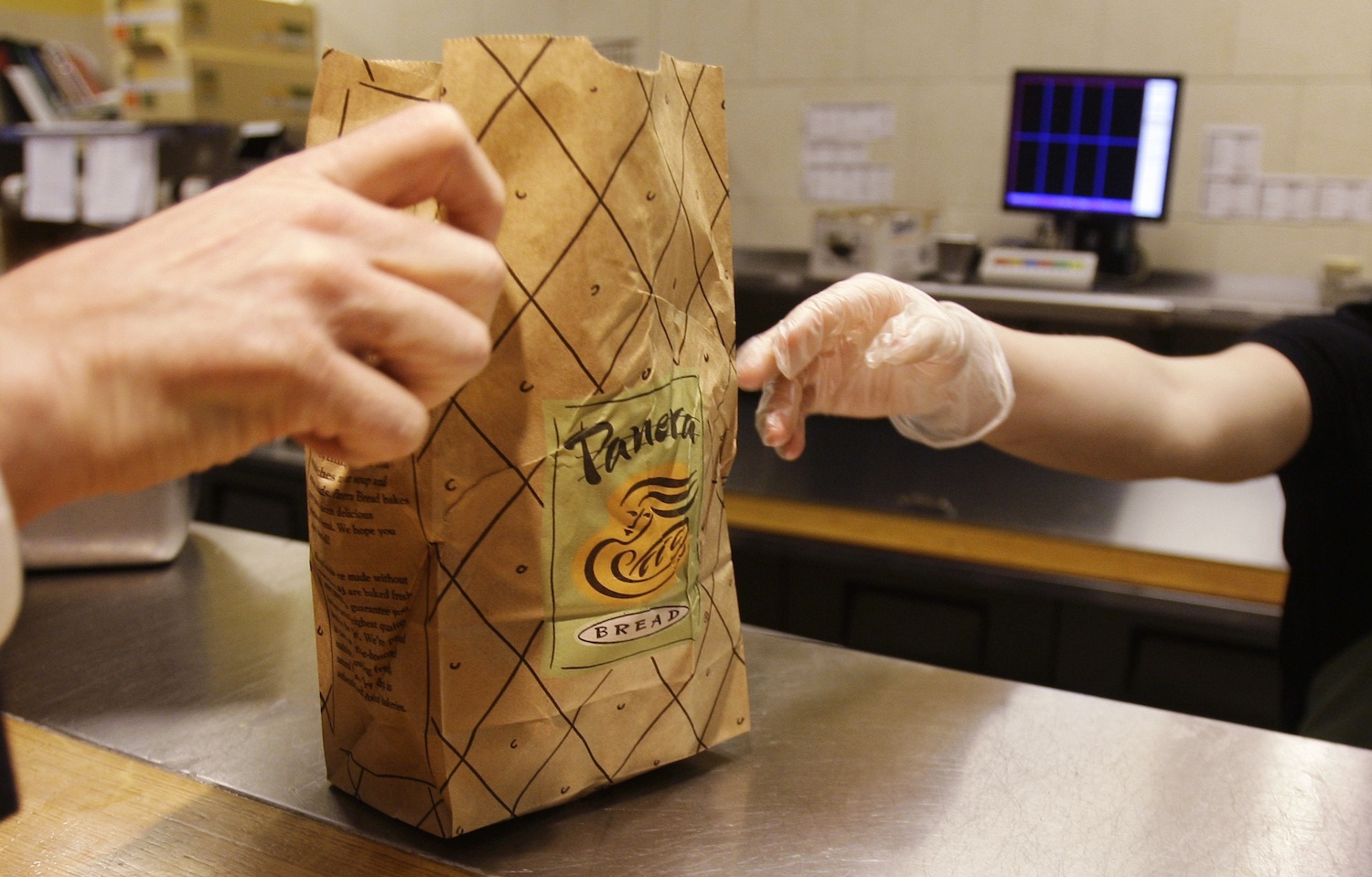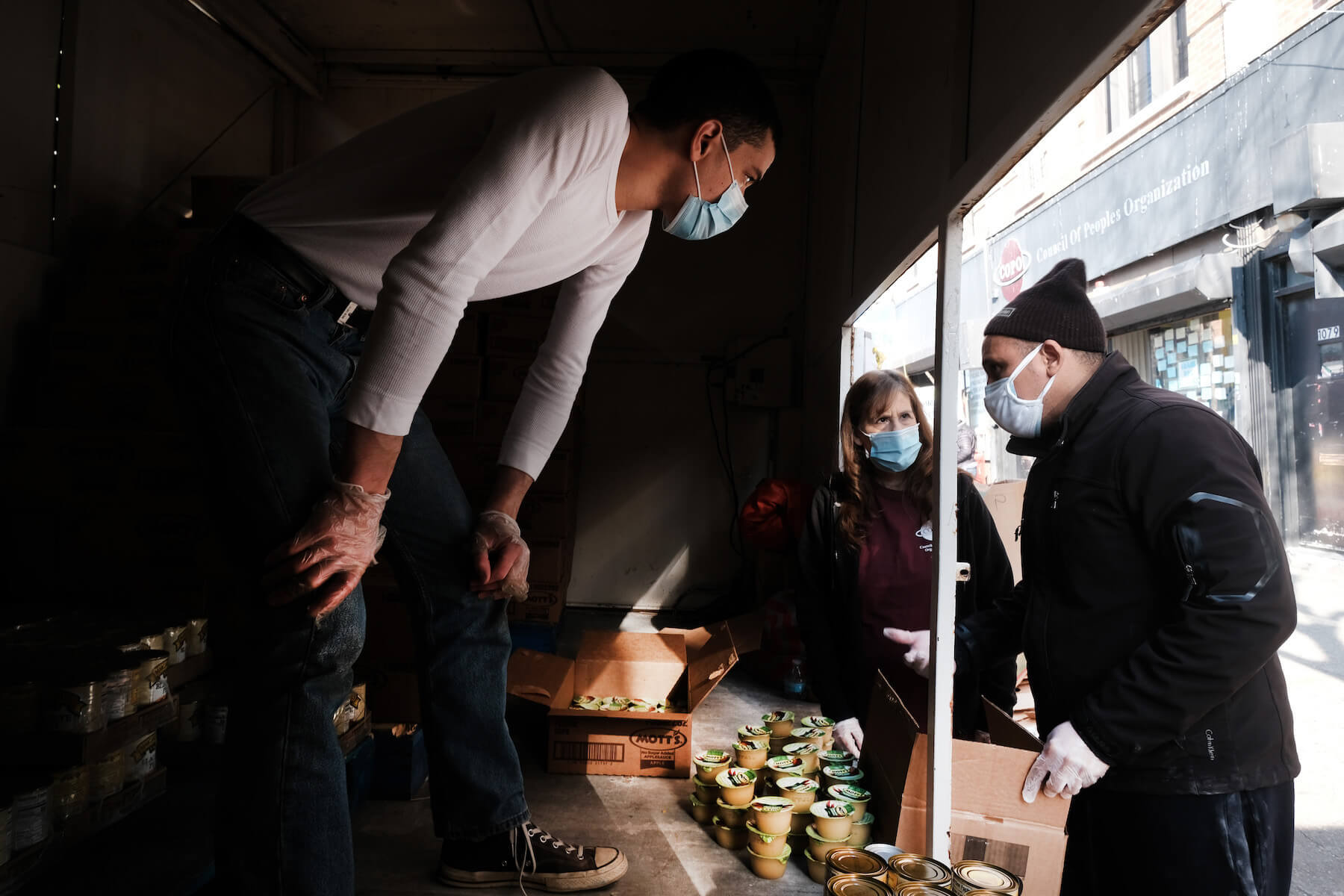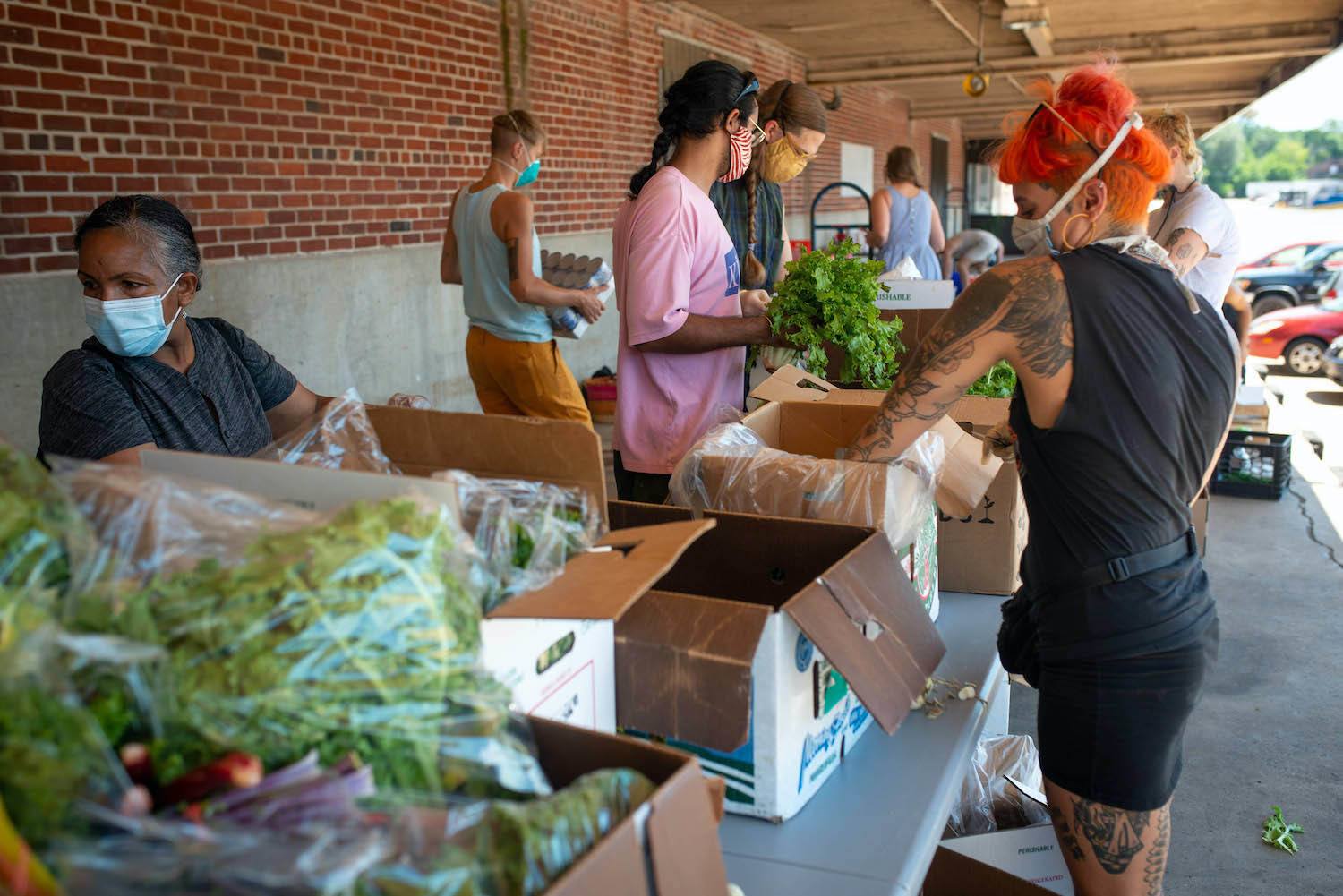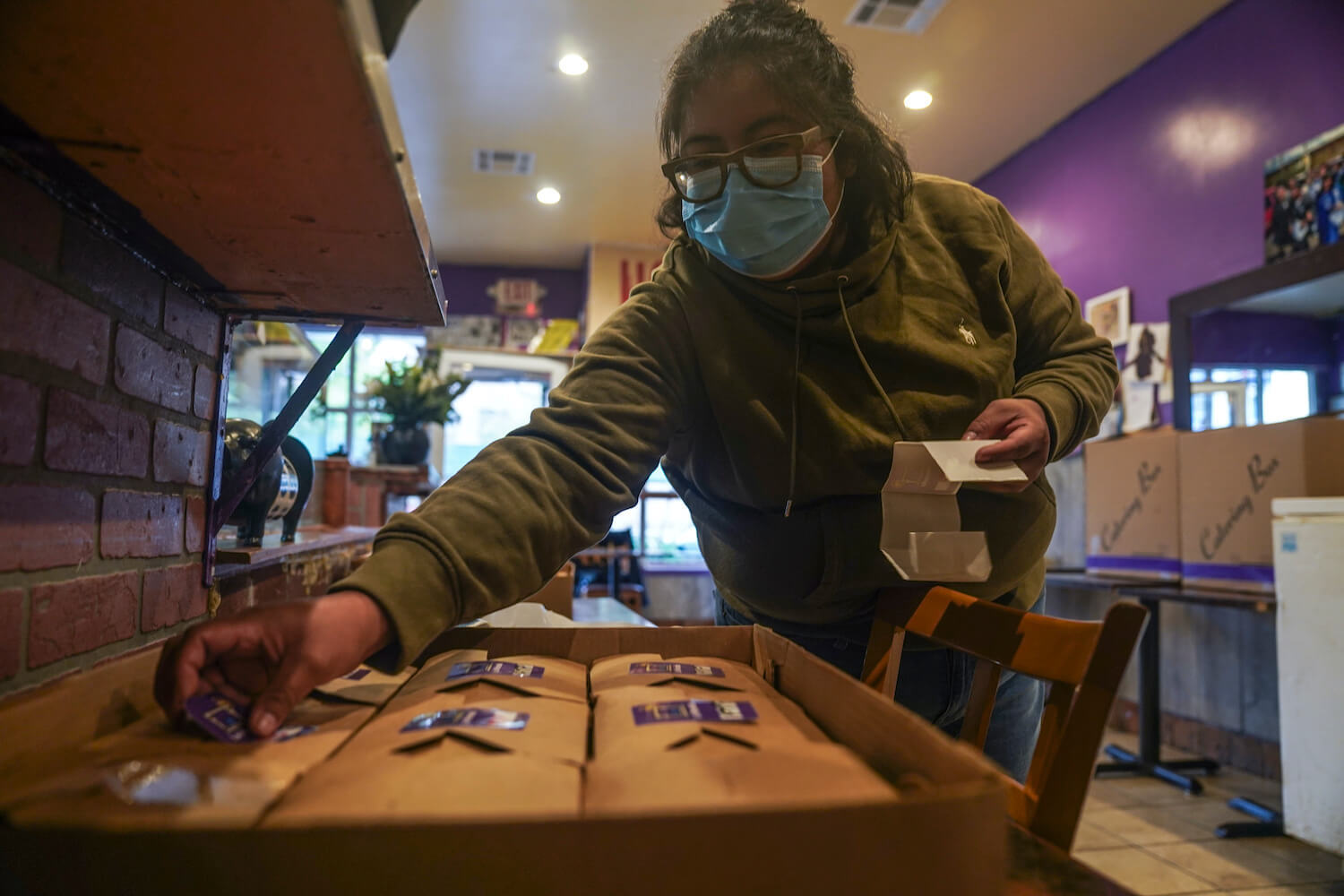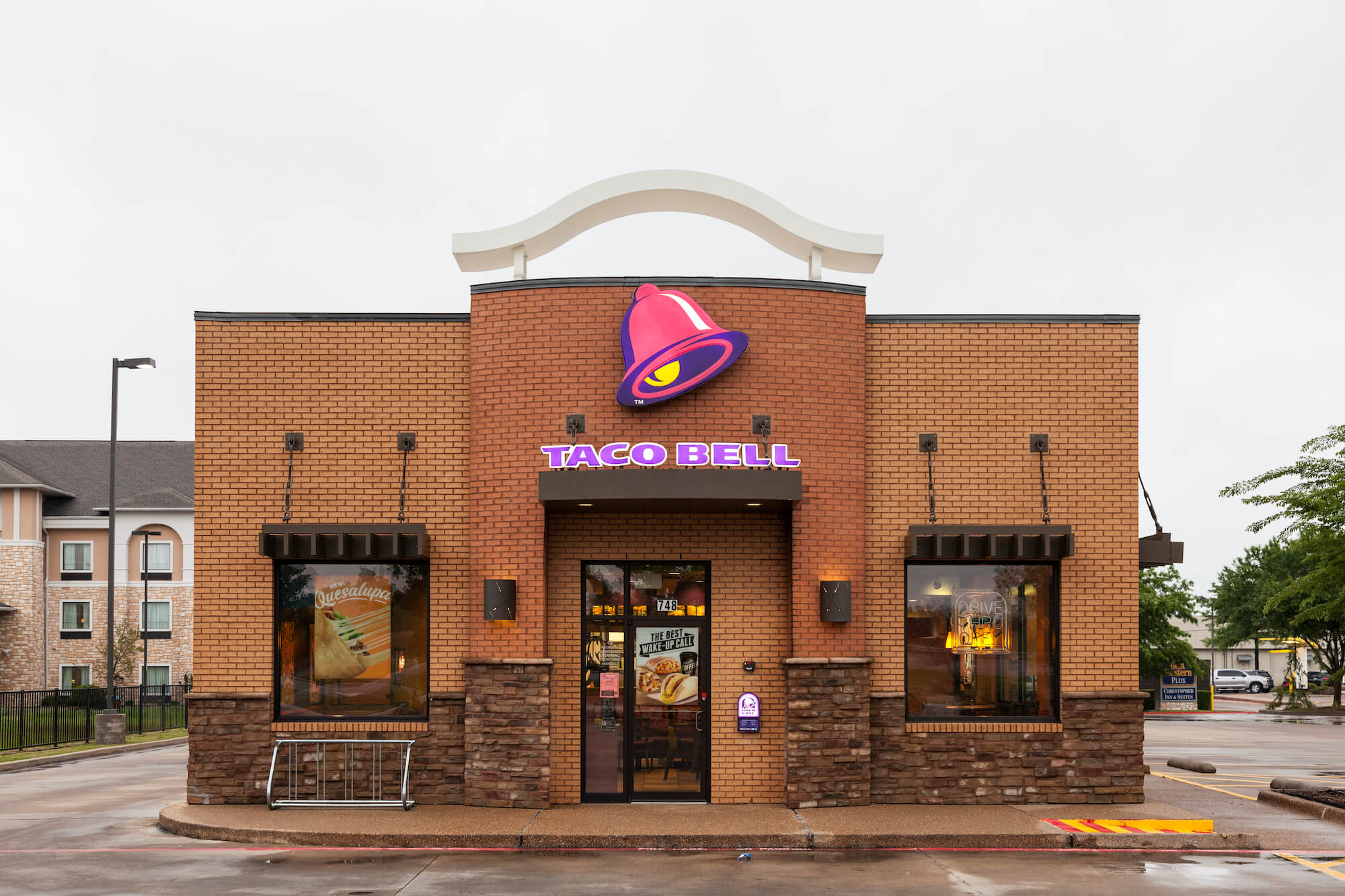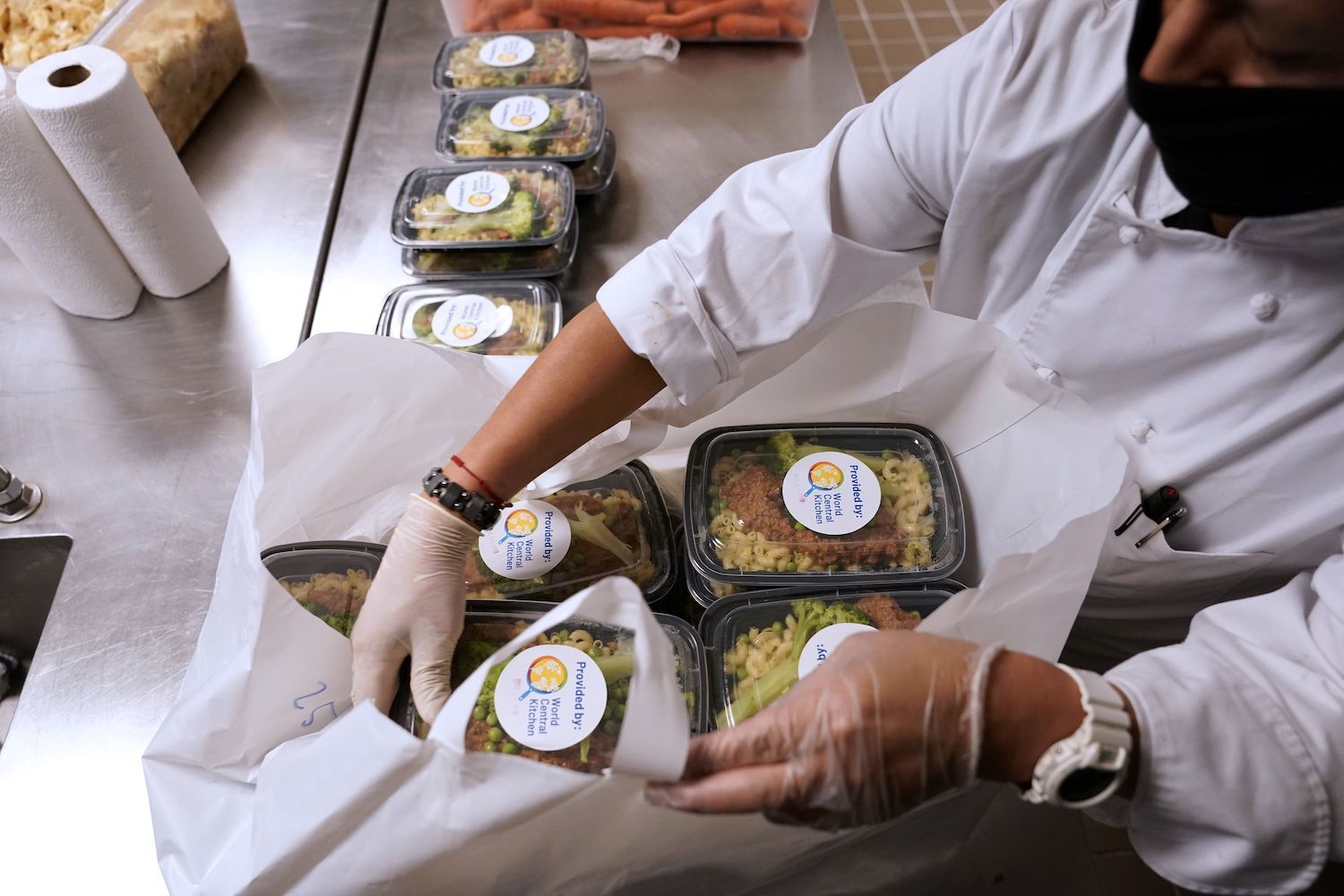
Timothy A. Clary/AFP via Getty Images
Biden’s new executive order is delightfully and deceptively simple: Restaurants can provide food aid and be reimbursed by FEMA at 100 percent. But FEMA isn’t in the funds-in-advance business, and that’s where it gets complicated.
Good intention is straightforward: President Biden issued an executive order on February 2, mandating 100 percent reimbursement for restaurants that provide food aid. Strapped restaurants can run an ancillary business while they limp toward full occupancy, and some of the Americans who worry about filling their plates can worry a bit less, at least until the order expires in September.
Implementation is something else again, a Medusa’s head of entangled bureaucracies, expected delays, and philanthropies stretched too thin to fill the money gap. At the center of it all? FEMA, the Federal Emergency Management Agency, best known for bungling Hurricane Katrina relief so badly that it underwent a mandated restructuring.
We’re about to see how well that remodel works.
Full compensation allows restaurants to do the right thing without hastening their own demise. No risk; only benefits.
The plan is delightfully and deceptively simple. Restaurants can provide food aid without spending a penny out of pocket, a good thing when occupancy rates still hover at or below half capacity, indoor dining is a rarity, and there isn’t enough cash to hire back the full staff or pay the rent, let alone invest in good deeds. The order supercedes the FEMA Empowering Essential Deliveries Act (FEED), which would have provided 75 percent reimbursement to an industry unable to make up the balance. Full compensation allows restaurants to do the right thing without hastening their own demise. No risk; only benefits.
Aid recipients will get a prepared meal—not an assortment of packaged, processed foods from a food bank but a meal, with all the nutritional advantage that implies. World Central Kitchen (WCK), the nonprofit founded by chef Jose Andres, has been making incursions into cities around the country since March, and if the results are any indication, better food is on the way. Chefs don’t abandon their standards because they’re on a tight budget. They take it as a challenge: What’s the best dinner I can make at two dollars per?
But FEMA is in the reimbursement business, not the funds-in-advance business, and that’s where it gets complicated. A willing restauranteur needs a partner with deep pockets to front the money for a food-aid program, someone who can afford to wait for FEMA to cut a check without having to turn out the lights. FEMA could take months that restaurants don’t have.
The go-between can’t be just anyone. WCK staff members are experts in the grim business of post-apocalypse food service, from Puerto Rico’s Hurricane Maria to California’s wildfires, and yet they cannot do business with FEMA directly because the agency reimburses only government entities at the city, county, or state level.
Even with the right partner, there’s one last, scary step: FEMA will only reimburse approved expenses, and no, there isn’t a list of what those are. Spend money up front and you risk having certain costs rejected. Submit projected costs in advance and you wait for an answer, and no, no one knows how long that will take. And the executive order includes but is not limited to restaurants. FEMA’s going to be looking at funding requests for everything from meals to masks to the cost of cleaning schools.
FEMA will only reimburse approved expenses, and no, there isn’t a list of what those are.
And one more thing: FEMA is broken into regions. There is no overarching reality, no definitive sense of how this is going to work.
It’s hard to overestimate how much this effort depends on the people who occupy the space between the principals, between restaurants and recipients. Nate Mook, WCK’s chief executive officer, says that since the pandemic began, the group has worked with over 2,500 restaurants in over 400 cities, from Boston to Atlanta to multiple sub-cities within Los Angeles.
In Boston, a WCK partnership enabled chef Douglass Williams to prepare an average of 800 meals a week at his restaurant, MIDA, sometimes as many as 1200—enough to hire back any member of his staff who was ready to return to work. He’d already started a pasta pop-up to keep “vulnerable employees,” people who didn’t qualify for unemployment, on the payroll. By summer’s end he had four businesses going simultaneously: pasta by the pound, WCK meals, restaurant take-out, and limited indoor dining.
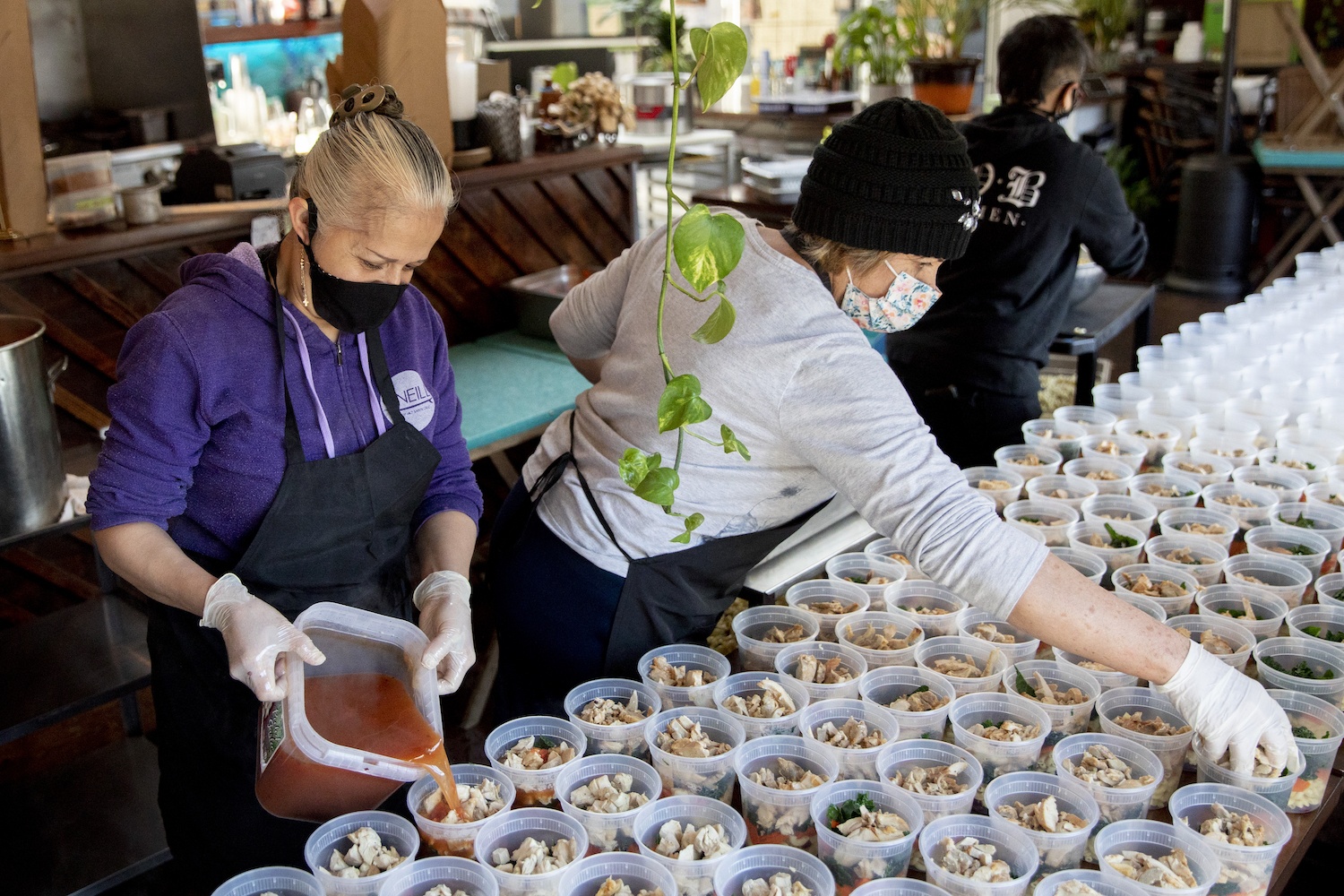
We may have a federal mandate to pay restaurants to feed people, but it’s not going to happen without a funding bridge that requires buy-in on the local level.
Jessica Christian/The San Francisco Chronicle via Getty Images
In Phoenix, chef Danielle Leoni closed her restaurant, The Breadfruit & Rum Bar, and turned WCK’s budget of two dollars per meal, with additional funds for production and labor, into “100 to 800 full meals in any given week.”
WCK was able to cobble together funds at the city level—but when they dried up, the organization had to follow the money to other cities, and the chefs had no choice but to reduce their output. Williams, who has since partnered with local hospitals and churches, estimates his volume at “probably five percent of what we did with WCK, really just a nod now.” Leoni buys chickens from her struggling supplier, stores them in her freezer, and does a monthly jerk chicken pop-up, nothing like the volume she did before.
“We’ve scaled back in a lot of places as philanthropic dollars ran out,” said Mook. “Philanthropy can’t do this alone—feed our country and save our restaurants based on people online giving $10 or $50 contributions.”
“Philanthropy can’t do this alone—feed our country and save our restaurants based on people online giving $10 or $50 contributions.”
Phoenix decided not to replace the non-profit funds with city money, a chilly predictor of what might happen to the new plan if other cities follow suit.
This isn’t a draft but a volunteer army, and without volunteers there’s no campaign. The executive order will work only as long as local governments free up funds, restaurants sign on, nonprofits continue to broker relationships—and FEMA does its job in a timely fashion.
Mook sees two ways it can work. In the first option, an experienced entity like WCK acts as “air traffic controller,” coordinating with cities to identify people in need and restaurants able to source meals. WCK has in the past taken on the immediate financial burden, paying restaurants for a prescribed number of meals while waiting for government reimbursement. But that is a “short-term” commitment, said Mook, as chefs in Boston and Phoenix have learned. “Our advantage is scale; we know how to tap into a wide base. But we have to know the money will flow in later if we’re going to tap our reserves.”
“Local governments are not known to be fast-moving; we have to make them comfortable that this is a win for them.”
The second option is for local governments to run programs directly. “Restaurants will essentially be government contractors,” said Mook. “They register with the system and the city finance department would pay them as it would anyone. Then the city would be responsible for getting reimbursed. And while restaurants would still be working with a government agency that might have a delay, it’s certainly much faster than working with the federal government.”
The problem with Plan B is reluctance from local officials worried about overextending the city’s obligations. “Implementation is going to require handholding to make cities comfortable,” said Mook. “Local governments are not known to be fast-moving; we have to make them comfortable that this is a win for them.” He’s faced layers of resistance even after seeming success: the Los Angeles board of supervisors passed a resolution to work with WCK and restaurants, but so far, the funding has not materialized.
“In a lot of ways cities are afraid of FEMA,” said Mook. “There’s a fear of getting denied. But if we get it right in one place, to start, then cities will see there’s a model to work with.”
Marco Shaw, vice-president of Atlanta’s Red Beard Restaurants and an eager advocate for restaurant food aid, says that two of the group’s restaurants worked with WCK and local nonprofits to prepare thousands of meals over the summer—which meant rehiring partial staff and covering health insurance costs for three months. Atlanta has a strong restaurant community and a strong mayor to advocate for city funding to extend the programs, “and our mayor will do what she can,” he said, but he’s realistic about whether the new reimbursement program will have much impact.
“It’s going to be a state issue,” he said. “I don’t know if the governor will be willing to take on the initial debt.”
We may have a federal mandate to pay restaurants to feed people, but it’s not going to happen without a funding bridge that requires buy-in on the local level. FEMA will not write checks to restaurants. FEMA will not even write checks to groups like WCK, though Mook hopes that might change in the future. As of now, FEMA writes checks only to local governments for whom this is an elective exercise.
Which leaves hungry people and income-hungry restaurants where, exactly? Not yet safe. Better odds, but no guarantee from one city to the next.
More people can enjoy not only the literal meal but the “symbolic” meal. “The idea that somebody has prepared this with love and intention.”
And yet the benefits of the executive order extend beyond the literal inventory of hundreds of meals per week multiplied, potentially, by thousands of participating restaurants. A partial list: More people can stop standing in lines for free food that might run out before they get to the front; more people can devote their energies to other aspects of pandemic recovery, like finding work and providing a more stable reality for their families; more people can enjoy not only the literal meal but the “symbolic” meal, said Mook, “the idea that somebody has prepared this with love and intention.”
And down the line, there’s an opportunity to improve the relationship between food aid and food recipients. Critics bemoan food handouts as a solution that perpetuates the need for food handouts, but Mook hopes restaurant aid will lead to providing “fresh produces boxes, to do more cooking at home.”
Not now, though. Later. “In a crisis,” he said, “you just have to get people through the day.”
The answer could be hiding in plain sight for owners who pay rent on a space 24 hours a day but only use it when they’re open for business.
The benefit list for restaurants includes the chance to rehire staff, to re-open kitchens, to support suppliers who suffer with them, to do good work—and potentially, to create a new operation that complements their restored restaurants. There’s been talk for years about how flawed the basic restaurant model is, with high fixed costs and menu price ceilings that have made “razor-thin profit margins” sound like a single compound noun—and talk more recently about the need for a wholesale overhaul, though it’s hard to see how the puzzle pieces might fit together in a better way.
The answer could be hiding in plain sight for owners who pay rent on a space 24 hours a day but only use it when they’re open for business. A dinner place could run a shift early in the day to make food-aid meals. A breakfast and lunch spot could transform itself in the late afternoon and evening hours. Two businesses could co-exist where one had lived before.
Granted, the timing isn’t great for a new enterprise. When Leoni and Williams embarked on their food-aid work, they had nothing else to do. Their restaurants were closed, their employees at risk. The executive order came out on the cusp of change coast to coast, as local governments leaned toward giving restaurants another chance to stay alive and customers another chance to behave. There’s momentum, now; owners preoccupied with plexiglass barriers and new ventilation systems may not be as quick to sign on for a program that looks nothing like what they do for a living.
“Our hope is that if those entities know the federal government will pay for this 100 percent, they’ll be willing to put the effort in.”
Cities are hamstrung as well. “The challenge is that states and cities and counties are so strapped, with huge budget shortfalls, not receiving sales tax revenues, huge deficits in lots of places,” said Mook. “Our hope is that if those entities know the federal government will pay for this 100 percent, they’ll be willing to put the effort in.”
—
So what do we have? Two chronic problems, one pandemic that’s made both of them worse, one elegantly clear solution, and a mess of potential glitches. And some ardent proselytizers with a new sense of what it means to feed people for a living, chefs who want to continue to lead a double life.
“Before, I would’ve looked at this as, ‘I’m not ready to start a second business,’ said Leoni. “But I had the chance because of the shutdown, and now I know exactly what to do. I can knock it out. And you should see the camaraderie in the kitchen when we do this. I’ve had this team for years, and they’re on fire together.”
“I’d get in the kitchen right now if there were the funding, the money up front.”
Williams sees need all around him, of the sort that will endure even after the pandemic fades and he has a restaurant again. MIDA is on “methadone mile,” a segment of Massachusetts Avenue where there are hospitals, treatment centers—and drug dealers in plain view. So he hunts for local financial partners and hopes that the executive order will improve his odds of success.
“I’d get in the kitchen right now if there were the funding, the money up front.”
And the Red Beard group has taken matters into its own hands by forming a nonprofit, The Defend Southern Food Foundation, which works with Second Helpings, a local nonprofit, to supply 2,500 dinners each week to families in need. The Cold Beer kitchen produces the meals, Second Helpings delivers them to seven area schools, and the schools distribute them at the end of the day.
That program won’t expire in September, because it doesn’t rely on FEMA aid. “We intend,” said Shaw, “to run this program in perpetuity.”
The restaurant industry has the chance to find solid ground by an unexpected route. People in need have the chance to replace food insecurity with the food surety that so many of us take for granted. All at no cost—as long as the places they call home make it a priority and solid alliances are put in place.

